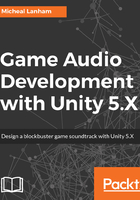
What this book covers
This book starts from the fundamentals of starting game audio development with Unity and progresses to using advanced commercial tools for professional game audio and music composition. It is assumed the reader will follow the chapters in sequential order as many chapters build from previous exercises. Each of the chapters is listed below with a quick summary:
Chapter 1, Introducing Game Audio in Unity, Unity is introduced and the reader is guided through installation of the software and setup of the first project. Which includes importing audio assets, audio source essentials and setting up spatial sounds.
Chapter 2, Scripting Audio, the basics of scripting in Unity is introduced with the writing of a simple musical keyboard. Followed by; scripting weapons, sound effects, physics and implementing ambient sounds and music.
Chapter 3, Introduction to the Unity Audio Mixer, introduces the basics of the Audio Mixer, mixing audio sources and effects, with further coverage on mixer signal routing and using the Duck Volume effect.
Chapter 4, Advanced Audio Mixing, covers using advanced capabilities of the Audio Mixer. From mixer parameter scripting, snapshots, snapshot transitions, and developing audio transition zones.
Chapter 5, Using the Audio Mixer for Adaptive Audio, introduces adaptive audio and covers techniques for mixing adaptive music.The rest of the chapter is spent implementing adaptive audio in sound and music.
Chapter 6, Introduction to FMOD, starts with the installation and setup of FMOD Studio. Then, it goes over the similarities and differences between the Unity Audio Mixer and FMOD.
Chapter 7, FMOD for Dynamic and Adaptive Audio, builds upon previous advanced examples and converts or adapts them to use FMOD. The chapter covers several advanced techniques of working with FMOD Studio.
Chapter 8, Visualizing Audio in Games, starts with a background of how sound can be broken down by frequency with mathematical techniques know as FFT Windowing. Those techniques are then used to create stunning audio-visual dancing lights and graphics.
Chapter 9, Character Lip Syncing and Vocals, builds upon previous work and builds a real-time character lip syncing demo. By covering character bone and vertex animation, lip-sync animation with phonemes, and recording with Unity.
Chapter 10, Composing Music, introduces the basics of music composition with Reaper using some simple music theory. It covers the installation and setup of Reaper, MIDI basics, virtual instruments, audio rendering and recording.
Chapter 11, Audio Performance and Troubleshooting, covers the fundamentals of audio performance with Unity and FMOD. From performance profiling to the tips and tricks of optimizing and troubleshooting performance issues.